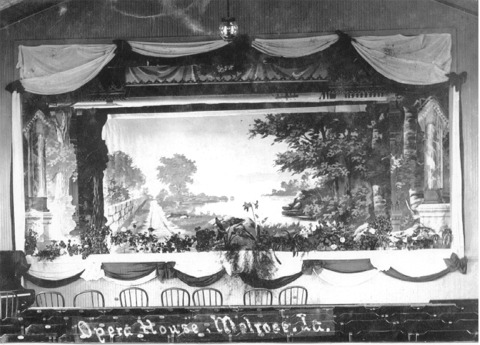| 1937 Melrose Shamrocks: The Championship Season | ||||||||||||||||||||||||
|
There were other interesting stories and facts about the Melrose team. Not all of the stories of that team dealt with how they won each game. Some of the best stories have nothing to do with what happened on the court. Of course, some did. City Slicker – Greasy
Hair:
Many of the players on
the Melrose basketball team wanted to fit in with the “big city” crowd of
Des Moines. In the fashion of
the day, they slicked back their hair with Rose Hair Oil. Rose Hair Oil was inexpensive
(“about 15 cents per gallon,” according to Walt O’Connor), so they
apparently used lots of it.
The oil also had a nice smell to it. Home Court – The Opera House: Unlike many of the large high schools, Melrose did not have its own gym. Instead, the team had to use the town Opera House for most practices and games. The term most big city newspapers used to describe the Opera House was a “cracker box.”
When basketball first started in Melrose in 1923, the School Board refused to consider the Opera House for the team because of the rent. This meant that the boys did drills on the cement floor of an old garage. Then, in 1925, the team took over the Opera House. The Opera House had a basketball floor
that was 40 to 45 feet long and 30 feet wide. In contrast, the Drake Fieldhouse
had a basketball floor that was 94 feet long and 50 feet wide. More than three Melrose basketball
floors could fit into the Drake Fieldhouse floor. The short Melrose floor meant that
the free throw circles overlapped the circle at center court. As Walt O’Connor observed, on the
small court, it was sometimes difficult to work up a sweat during
practices. Besides the unique size, the Opera
House had many other unique features. One of the baskets was mounted on
the stage of the Opera House.
The other basket was connected to a projection booth. A stove that provided the only
heat for the building cut off a corner of the floor. A guardrail protected the players
from the hot stove and was considered out of bounds. During practices, the guardrail
served as a bench. The Opera House had no bleachers. Instead, two by twelve foot planks
attached to wooden kegs provided limited seating. Team benches were made the same
way. In addition, 15 to 20
school kids sat on the stage to watch games. The Opera House had no running
water. It also had only one
locker room that both teams shared. After the 1937 championship, the town
of Melrose built a new community center. When it was finished in September
of 1939, it became the new home court for the Shamrocks. The Opera House was no longer
needed, and was torn down for the lumber in October of 1940. Although Melrose had a unique
basketball facility, some of their opponents had their own interesting
facilities. Bussey, for
instance, had a gym with a very low ceiling with pipes hanging down. This arrangement made it hard to
throw long shots or passes.
Hiteman played in an old, converted church that had a metal grate
in the middle of the floor.
According to Walt O’Connor, players had to bounce the ball hard on
the grate to get it back up to dribbling level. Russell had a nice gym and let
Melrose hold some practices on their floor before the State
Tournament. Traveling in a Black
Mariah: Melrose did not have a bus for the team to use when traveling
to its away games. However,
they found another vehicle in town that could hold all the players – a
“Black Mariah.” A Black
Mariah was a black Chevy panel van used to transport the dearly
departed. In other words, the
team went to some of its away games in the back of the town hearse. However, for the State Tournament,
they traveled in two cars. Shamrock Shorts: The following are other miscellaneous, interesting facts about the 1937 Melrose team and its fans:.
|
||||||||||||||||||||||||
|
|
||||||||||||||||||||||||
